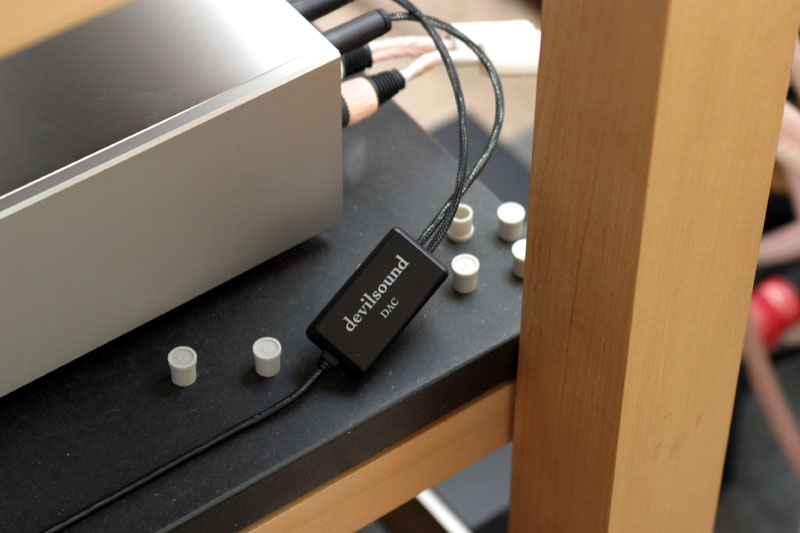Vivid Speakers, Vivid Music
ne of the benefits of living in Central Arizona is proximity to California, where a great number of audio companies reside. I've made three audio-related trips to the Golden State this year, and Philip O'Hanlon, the distributor of Vivid Audio speakers, Luxman electronics, Brinkmann turntables, and the new Devilsound USB DAC, has visited me twice. Philip lives in San Juan Capistrano, which is a residential Garden of Eden. I visited him in order to hear the Vivid Giya G1 speakers in his massive listening room. A pair of these speakers now resides in my smaller room. Philip rented a van to haul the speakers, a profusion of Luxman electronics, and sundry other products to my house. Needless to say, a review of the speakers is in the works.
I've heard the Giya G1s ($58,000/pair) a number of times at CES and the Rocky Mountain Audio Fest. Such well-appointed setups can cause you to forget that the speakers, along with everything else, had to be unpacked and set up by someone. The ugly truth became apparent shortly after Philip's van rolled into my driveway. The crates for the Giyas are mammoth, though luckily they come with wheels on one end and the Giyas themselves are lighter than other like-sized speakers. Philip and I spent the first couple of hours wresting the speakers and electronics into my house, We unboxed everything, connected it all, and then went to dinner. Fine-tuning would take place the next morning.
With the positions of the speakers the Giyas replaced, Wilson Audio MAXX 3s, as starting points, Philip played some special stereo recordings made from multichannel masters to set the speakers' distance from the listening seat and determine proper toe-in. After that, we listened to conventional stereo tracks we knew well, made a few small adjustments, and left the speakers where they were at that point. We didn't spike them because Philip feels that doing so doesn't improve the sound to any great degree. I have the spikes and will definitely experiment. From the front, the Giya G1s are shaped like bowling pins, which makes them more tipsy than speakers with broad bases, so spiking them is a two-person job. Philip always travels with an abundance of music -- in several formats, both analog and digital. As he has done in the past, he hauled along one of his ReVox reel-to-reel tape decks that has been modified to include the IEC EQ setting necessary for playing Tape Project reel-to-reel recordings. These are essentially second-generation master tapes, and they are created in real time to preserve their amazing fidelity. In the past I've gotten to hear vintage-jazz tracks via this same setup, but this time Philip brought a couple of new demo tapes that included great tracks by the Staple Singers. Über-powerful Luxman B-1000f amps ($53,000/pair) drove the Giyas to levels at which I would never listen for long, and did so without a hint of strain, the tapes providing the proverbial sonic window into the recording studio. The Tape Project tapes are not cheap at over $300 each, but what is a copy of a master tape worth? If I come into a few thousand dollars of extra income, I know how I'll be spending it. A SonoruS-modified Luxman DU-80 universal player ($10,500 plus $2000 for the mods) portrayed music with acute precision, leading me to understand better why Philip has chosen to distribute Vivid speakers and Luxman electronics: their transient speed and overall fidelity are unerring. He eventually unpacked his latest playback devices -- an Apple MacBook, which he connected via a long USB cable to the small, easy-to-hide Devilsound USB digital-to-analog converter ($400).
This was a fascinating front-end -- as much for its user-friendliness as its sound. The MacBook's contribution was straightforward enough -- it stored and cataloged the music via the iTunes software. CDs were ripped uncompressed, of course. Philip has a fair amount of high-resolution music on his MacBook, but the Devilsound DAC offers CD resolution only. A 24-bit/96kHz asynchronous version is in the works, and I should get to play with it sometime next year. Philip controlled the MacBook with his iPhone, which nearly duplicated the former's user interface.
As I pointed out last month in response to a reader letter, the convenience of a computer-based system has no influence on me. I have no issues playing my CDs just as I always have. I am also not persuaded by the comparatively small number of high-resolution recordings available for download. However, I would value being able to download a high-resolution version of Kind of Blue and other great recordings; easy availability to great music in a high-resolution format could make me change my tune. The MacBook/Devilsound DAC system sounded very smooth and a touch full, though it clearly lacked the snappy pace and see-throughness of the modified Luxman player. For background music or party programming, this system would be a godsend. Look for my review of the Vivid Giya G1s next month and
coverage of the next-generation Devilsound DAC next year. |




